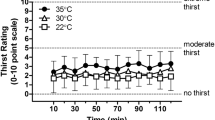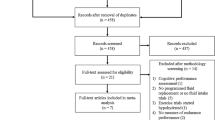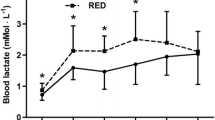Abstract
Hydration guidelines found in the scientific and popular literature typically advise that body mass losses beyond 2% should be avoided during exercise. In this work, we demonstrate that these guidelines are not applicable to prolonged exercise of several hours where body mass loss does not reflect an equivalent loss of body water due to the effects of body mass change from substrate use, release of water bound with muscle and liver glycogen, and production of water during substrate metabolism. These effects on the body mass loss required to maintain body water balance are shown for a 161-km mountain ultramarathon running competition participant utilizing published data for the total energy cost, exogenous energy consumption and percentage from each fuel source, average participant body mass, and the extent of soft tissue fluid accumulation during an ultramarathon. We assumed that total energy derived from protein ranges from 5 to 10%, all exogenous energy is used to support the energy cost of the race, glycogen utilization ranges from 300 to 500 g, water linked with glycogen ranges from 1 to 3 g per g of glycogen, and the mass of the bladder and gastrointestinal tract is unchanged from pre-race to post-race body mass measurements. These calculations show that the average participant of 68.8 kg must lose 1.9–5.0% body mass to maintain the water supporting body water balance while also avoiding overhydration. Future hydration guidelines should consider these findings so that the proper hydration message is conveyed to those who participate in prolonged exercise.

Similar content being viewed by others
Change history
11 October 2018
In Table 2 of the original publication, an error was made in the calculations for endogenous substrate oxidation which, subsequently, altered the values for total change in body mass.
References
American College of Sports Medicine, Armstrong LE, Casa DJ, et al. American College of Sports Medicine position stand. Exertional heat illness during training and competition. Med Sci Sports Exerc. 2007;39:556–72.
American College of Sports Medicine, Sawka MN, Burke LM, et al. American College of Sports Medicine position stand. Exercise and fluid replacement. Med Sci Sports Exerc. 2007;39:377–90.
American Dietetic Association; Dietitians of Canada, American College of Sports Medicine, Rodriguez NR. American College of Sports Medicine position stand. Nutrition and athletic performance. Med Sci Sports Exerc. 2009;41:709–31.
Casa DJ, Armstrong LE, Hillman SK, et al. National Athletic Trainers’ Association position statement: fluid replacement for athletes. J Athl Train. 2000;35:212–24.
Casa DJ, Clarkson PM, Roberts WO. American College of Sports Medicine roundtable on hydration and physical activity: consensus statements. Curr Sports Med Rep. 2005;4:115–27.
Kreider RB, Wilborn CD, Taylor L, et al. ISSN exercise & sport nutrition review: research & recommendations. J Int Soc Sports Nutr. 2010;2(7):7.
Thomas DT, Erdman KA, Burke LM. American College of Sports Medicine joint position statement. Nutrition and athletic performance. Med Sci Sports Exerc. 2016;48:543–68.
Hoffman MD, Bross TL 3rd, Hamilton RT. Are we being drowned by overhydration advice on the Internet? Phys Sportsmed. 2016;44:343–8.
Cotter JD, Thornton SN, Lee JK, et al. Are we being drowned in hydration advice? Thirsty for more? Extrem Physiol Med. 2014;3:18.
Goulet ED. Effect of exercise-induced dehydration on endurance performance: evaluating the impact of exercise protocols on outcomes using a meta-analytic procedure. Br J Sports Med. 2013;47:679–86.
Goulet ED. Effect of exercise-induced dehydration on time-trial exercise performance: a meta-analysis. Br J Sports Med. 2011;45:1149–56.
Hoffman MD, Cotter JD, Goulet ÉD, et al. VIEW: is drinking to thirst adequate to appropriately maintain hydration status during prolonged endurance exercise? Yes. Wilderness Environ Med. 2016;27:192–5.
Noakes TD, Sharwood K, Speedy D, et al. Three independent biological mechanisms cause exercise-associated hyponatremia: evidence from 2,135 weighed competitive athletic performances. Proc Natl Acad Sci USA. 2005;102:18550–5.
Noakes T. Fluid replacement during marathon running. Clin J Sport Med. 2003;13:309–18.
Noakes TD. Drinking guidelines for exercise: what evidence is there that athletes should drink “as much as tolerable”, “to replace the weight lost during exercise” or “ad libitum”? J Sports Sci. 2007;25:781–96.
Hoffman MD, Stuempfle KJ. Muscle cram** during a 161-km ultramarathon: comparison of characteristics of those with and without cram**. Sports Med Open. 2015;1:8.
Maughan RJ. Exercise-induced muscle cramp: a prospective biochemical study in marathon runners. J Sports Sci. 1986;4(1):31–4.
Schwellnus MP, Nicol J, Laubscher R, et al. Serum electrolyte concentrations and hydration status are not associated with exercise associated muscle cram** (EAMC) in distance runners. Br J Sports Med. 2004;38:488–92.
Nolte HW, Noakes TD, Van Vuuren B. Protection of total body water content and absence of hyperthermia despite 2% body mass loss (‘voluntary dehydration’) in soldiers drinking ad libitum during prolonged exercise in cool environmental conditions. Br J Sports Med. 2011;45:1106–12.
Tam N, Nolte HW, Noakes TD. Changes in total body water content during running races of 21.1 km and 56 km in athletes drinking ad libitum. Clin J Sport Med. 2011;21:218–25.
Maughan RJ, Shirreffs SM, Leiper JB. Errors in the estimation of hydration status from changes in body mass. J Sports Sci. 2007;25:797–804.
Cermak NM, van Loon LJ. The use of carbohydrates during exercise as an ergogenic aid. Sports Med. 2013;43:1139–55.
Romijn JA, Coyle EF, Sidossis LS, et al. Regulation of endogenous fat and carbohydrate metabolism in relation to exercise intensity and duration. Am J Physiol Endocrinol Metab. 1993;265:E380–91.
van Loon LJ, Greenhaff PL, Constantin-Teodosiu D, et al. The effects of increasing exercise intensity on muscle fuel utilisation in humans. J Physiol. 2001;536:295–304.
Holloszy JO, Coyle EF. Adaptations of skeletal muscle to endurance exercise and their metabolic consequences. J Appl Physiol. 1984;56:831–8.
Romijn JA, Klein S, Coyle EF, et al. Strenuous endurance training increases lipolysis and triglyceride fatty acid cycling at rest. J Appl Physiol. 1993;75:108–13.
Betts JA, Williams C, Boobis L, et al. Increased carbohydrate oxidation after ingesting carbohydrate with added protein. Med Sci Sports Exerc. 2008;40:903–12.
Gonzalez JT, Veasey RC, Rumbold PL, et al. Breakfast and exercise contingently affect postprandial metabolism and energy balance in physically active males. Br J Nutr. 2013;110:721–32.
Wallis GA, Dawson R, Achten J, et al. Metabolic response to carbohydrate ingestion during exercise in males and females. Am J Physiol Endocrinol Metab. 2006;290:E708–15.
Yeo WK, Carey AL, Burke L, et al. Fat adaptation in well-trained athletes: effects on cell metabolism. Appl Physiol Nutr Metab. 2011;36:12–22.
Tarnopolsky M. Protein requirements for endurance athletes. Nutrition. 2004;20:662–8.
Bergström J, Hermansen L, Hultman E, et al. Diet, muscle glycogen and physical performance. Acta Physiol Scand. 1967;71(2):140–50.
Hermansen L, Hultman E, Saltin B. Muscle glycogen during prolonged severe exercise. Acta Physiol Scand. 1967;71(2):129–39.
McBride JJ, Mason Guest M, Scott EL. The storage of the major liver components; emphasizing the relationship of glycogen to water in the liver and the hydration of glycogen. J Biol Chem. 1941;139:943–52.
Pukett HL, Wiley FH. The relation of glycogen to water storage in the liver. J Biol Chem. 1932;96:367–71.
Geddes R, Harvey JD, Wills PR. The molecular size and shape of liver glycogen. Biochem J. 1977;163:201–9.
Ollson KE, Saltin B. Variation in total body water with muscle glycogen changes in man. Acta Physiol Scand. 1970;80:11–8.
Sherman WM, Plyley MJ, Sharp RL, et al. Muscle glycogen storage and its relationship with water. Int J Sports Med. 1982;3(1):22–4.
Dion T, Savoie FA, Asselin A, et al. Half-marathon running performance is not improved by a rate of fluid intake above that dictated by thirst sensation in trained distance runners. Eur J Appl Physiol. 2013;113:3011–20.
Rogers G, Goodman C, Rosen C. Water budget during ultra-endurance exercise. Med Sci Sports Exerc. 1997;29:1477–81.
Cejka C, Knechtle B, Knechtle P, et al. An increased fluid intake leads to feet swelling in 100-km ultra-marathoners—an observational field study. J Int Soc Sports Nutr. 2012;9(1):11.
Bracher A, Knechtle B, Gnädinger M, et al. Fluid intake and changes in limb volumes in male ultra-marathoners: does fluid overload lead to peripheral oedema? Eur J Appl Physiol. 2012;112:991–1003.
Lundvall J, Mellander S, White T. Hyperosmolality and vasodilatation in human skeletal muscle. Acta Physiol Scand. 1969;77(1):224–33.
Cuddy J, Slivka D, Hailes W, et al. Total energy expenditure, body water turnover, hydration status, and blood composition during the Western States 100. Med Sci Sports Exerc. 2009;41:S336–7.
Dumke CL, Shooter L, Lind RH, et al. Indirect calorimetry during ultradistance running: a case report. J Sports Sci Med. 2006;5:692–8.
Ruby BC, Cuddy JS, Hailes WS, et al. Extreme endurance and the metabolic range of sustained activity is uniquely available for every human not just the elite few. Comp Exer Physiol. 2015;11:1–7.
Stuempfle KJ, Hoffman MD, Weschler LB, et al. Race diet of finishers and non-finishers in a 100 mile (161 km) mountain footrace. J Am Coll Nutr. 2011;30:529–35.
Hoffman MD, Hew-Butler T, Stuempfle KJ. Exercise-associated hyponatremia and hydration status in 161-km ultramarathoners. Med Sci Sports Exerc. 2013;45:784–91.
Hoffman MD, Stuempfle KJ. Hydration strategies, weight change and performance in a 161 km ultramarathon. Res Sports Med. 2014;22:213–25.
Coler C, Hoffman MD, Towle G, et al. Hyponatremia in an 85-year-old hiker: when depletion plus dilution produces delirium. Wilderness Environ Med. 2012;23:153–7.
Frizzell RT, Lang GH, Lowance DC, et al. Hyponatremia and ultramarathon running. JAMA. 1986;255:772–4.
Gardner JW. Death by water intoxication. Mil Med. 2002;167:432–4.
Garigan TP, Ristedt DE. Death from hyponatremia as a result of acute water intoxication in an Army basic trainee. Mil Med. 1999;164:234–8.
Pearce EA, Myers TM, Hoffman MD. Three cases of severe hyponatremia during a river run in Grand Canyon National Park. Wilderness Environ Med. 2015;26:189–95.
Winger JM, Hoffman MD, Hew-Butler TD, et al. The effect of physiology and hydration beliefs on race behavior and postrace sodium in 161-km ultramarathon finishers. Int J Sports Physiol Perform. 2013;8:536–41.
Hoffman MD, Stuempfle KJ. Is sodium supplementation necessary to avoid dehydration during prolonged exercise in the heat? J Strength Cond Res. 2016;30(3):615–20.
Hoffman MD, Stuempfle KJ, Sullivan K, Weiss RH. Exercise-associated hyponatremia with exertional rhabdomyolysis: importance of proper treatment. Clin Nephrol. 2015;83(4):235–42.
Anonymous. Bushwalker died from drinking too much water. The Sydney Morning Herald. 2012 Sep 17. http://www.smh.com.au/national/bushwalker-died-from-drinking-too-much-water-20120917-2621c.html. Accessed 31 Mar 2017.
Hew-Butler T, Rosner MH, Fowkes-Godek S, et al. Statement of the third international exercise-associated hyponatremia consensus development conference, Carlsbad, California, 2015. Clin J Sport Med. 2015;25:303–20.
Krabel H. Athlete dies after IM Frankfurt. Slowtwitch.com. 2015. http://www.slowtwitch.com/News/Athlete_dies_after_IM_Frankfurt_5190.html. Accessed 9 Jan 2017.
HS football player dies from drinking too much fluid. WYFF4.com. 2014. http://www.wyff4.com/news/hs-football-player-dies-from-drinking-too-much-fluid/27409692. Accessed 9 Jan 2017.
Lilley K. West Point grad dies after hospitalization during Ranger School. Army Times. 2016 Jul 28. http://www.armytimes.com/story/military/2016/07/28/west-point-grad-dies-after-hospitalization-during-ranger-school/87660358/. Accessed 9 Jan 2017.
Williams A. Jackson Prep football player dies. WAPT News. 2014. http://www.wapt.com/news/central-mississippi/jackson/jackson-prep-prays-for-hospitalized-football-player/27712666. Accessed 9 Jan 2017.
Hoffman MD, Pasternak A, Rogers IR, et al. Medical services at ultra-endurance foot races in remote environments: medical issues and consensus guidelines. Sports Med. 2014;44:1055–69.
Acknowledgments
This material is the result of work supported with resources and the use of facilities at the VA Northern California Health Care System. The contents reported here do not represent the views of the Department of Veterans Affairs or the United States Government.
Author information
Authors and Affiliations
Corresponding author
Ethics declarations
Conflict of interest
Martin D. Hoffman, Eric D. Goulet, and Ronald J. Maughan declare that they have no potential conflicts of interest that are directly relevant to the content of this article.
Funding
No funding was received for the conduct of the work or for preparation of the manuscript.
Rights and permissions
About this article
Cite this article
Hoffman, M.D., Goulet, E.D.B. & Maughan, R.J. Considerations in the Use of Body Mass Change to Estimate Change in Hydration Status During a 161-Kilometer Ultramarathon Running Competition. Sports Med 48, 243–250 (2018). https://doi.org/10.1007/s40279-017-0782-3
Published:
Issue Date:
DOI: https://doi.org/10.1007/s40279-017-0782-3




